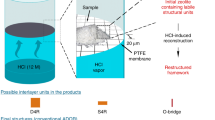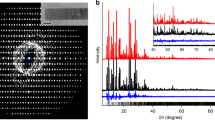Abstract
The assembly–disassembly–organization–reassembly (ADOR) mechanism is a recent method for preparing inorganic framework materials and, in particular, zeolites. This flexible approach has enabled the synthesis of isoreticular families of zeolites with unprecedented continuous control over porosity, and the design and preparation of materials that would have been difficult—or even impossible—to obtain using traditional hydrothermal techniques. Applying the ADOR process to a parent zeolite with the UTL framework topology, for example, has led to six previously unknown zeolites (named IPC-n, where n = 2, 4, 6, 7, 9 and 10). To realize the full potential of the ADOR method, however, a further understanding of the complex mechanism at play is needed. Here, we probe the disassembly, organization and reassembly steps of the ADOR process through a combination of in situ solid-state NMR spectroscopy and powder X-ray diffraction experiments. We further use the insight gained to explain the formation of the unusual structure of zeolite IPC-6.
This is a preview of subscription content, access via your institution
Access options
Access Nature and 54 other Nature Portfolio journals
Get Nature+, our best-value online-access subscription
$29.99 / 30 days
cancel any time
Subscribe to this journal
Receive 12 print issues and online access
$259.00 per year
only $21.58 per issue
Buy this article
- Purchase on Springer Link
- Instant access to full article PDF
Prices may be subject to local taxes which are calculated during checkout





Similar content being viewed by others
References
Roth, W. J. et al. A family of zeolites with controlled pore size prepared using a top-down method. Nat. Chem. 5, 628–633 (2013).
Eliasova, P. et al. The ADOR mechanism for the synthesis of new zeolites. Chem. Soc. Rev. 44, 7177–7206 (2015).
Mazur, M. et al. Synthesis of ‘unfeasible’ zeolites. Nat. Chem. 8, 58–62 (2016).
Wheatley, P. S. et al. Zeolites with continuously tuneable porosity. Angew. Chem. Int. Ed. 53, 13210–13214 (2014).
Morris, R. E. & Cejka, J. Exploiting chemically selective weakness in solids as a route to new porous materials. Nat. Chem. 7, 381–388 (2015).
Paillaud, J. L., Harbuzaru, B., Patarin, J. & Bats, N. Extra-large-pore zeolites with two-dimensional channels formed by 14 and 12 rings. Science 304, 990–992 (2004).
Corma, A., Diaz-Cabanas, M. J., Rey, F., Nicolooulas, S. & Boulahya, K. ITQ-15: the first ultralarge pore zeolite with a bi-directional pore system formed by intersecting 14- and 12-ring channels, and its catalytic implications. Chem. Comm. 2004, 1356–1357 (2004).
Corma, A., Rey, F., Valencia, S., Jorda, J. L. & Rius, J. A zeolite with interconnected 8-, 10- and 12-ring pores and its unique catalytic selectivity. Nat. Mater. 2, 493–497 (2003).
Chlubna-Eliasova, P. et al. The assembly-disassembly-organization-reassembly mechanism for 3D-2D-3D transformation of germanosilicate IWW zeolite. Angew. Chem. Int. Ed. 53, 7048–7052 (2014).
Lorgouilloux, Y. et al. IM-17: a new zeolitic material, synthesis and structure elucidation from electron diffraction ADT data and Rietveld analysis. RSC Adv. 4, 19440–19449 (2014).
Kasneryk, V. et al. Expansion of the ADOR strategy for the synthesis of new zeolites: the synthesis of IPC-12 from zeolite UOV. Angew. Chem. Int. Ed. https://doi.org/10.1002/anie.201700590 (2017).
Roth, W. J. et al. Postsynthesis transformation of three-dimensional framework into a lamellar zeolite with modifiable architecture. J. Am. Chem. Soc. 133, 6130–6133 (2011).
Proffen, T. & Neder, R. B. DISCUS: A program for diffuse scattering and defect-structure simulation. J. Appl. Crystallogr. 30, 171–175 (1997).
Slawinski, W. A., Wragg, D. S., Akporiyae, D. & Fjellvag, H. Intergrowth structure modelling in silicoaluminophosphate SAPO-18/34 family. Micropor. Mesopor. Mater. 195, 311–318 (2014).
Smith, R. L. et al. Nanoporous intergrowths: how crystal growth dictates phase composition and hierarchical structure in the CHA/AEI system. Chem. Mater. 27, 4205–4215 (2015).
Sartbaeva, A., Wells, S. A., Treacy, M. M. J. & Thorpe, M. F. The flexibility window in zeolites. Nat. Mater. 5, 962–965 (2006).
Dawson, C. J., Kapko, V., Thorpe, M. F., Foster, M. D. & Treacy, M. M. J. Flexibility as an indicator of feasibility of zeolite frameworks. J. Phys. Chem. C 116, 16175–16181 (2012).
Massiot, D. et al. Modelling one- and two-dimensional solid-state NMR spectra. Magn. Reson. Chem. 40, 70–76 (2002).
Acknowledgements
R.E.M. and M.N. thank the Royal Society and the Engineering and Physical Sciences Research Council (EPSRC) (Grants EP/L014475/1, EP/K025112/1 and EP/K005499/1) for funding work in this area. R.E.M. and J.Č. acknowledge the Czech Science Foundation for the project, P106/12/G015 and OP VVV “Excellent Research Teams”, project no. CZ.02.1.01/0.0/0.0/15_003/0000417, CUCAM. S.E.A. would like to thank the European Research Council (EU FP7 Consolidator Grant 614290 “EXONMR”) and the Royal Society and Wolfson Foundation for a merit award. We thank C. Tang for his assistance with the synchrotron PXRD work carried out at the Diamond Light Source, UK. The UK 850 MHz solid-state NMR Facility used in this research was funded by EPSRC and BBSRC (contract reference PR140003), as well as the University of Warwick including via part funding through Birmingham Science City Advanced Materials Projects 1 and 2 supported by Advantage West Midlands (AWM) and the European Regional Development Fund (ERDF). Collaborative assistance from the 850 MHz facility manager (D. Iuga, University of Warwick) is acknowledged. W.A.S. and D.S.W. acknowledge the Research Council of Norway for providing the computer time at the Norwegian supercomputer facilities (under the project number NN2875k).
Author information
Authors and Affiliations
Contributions
P.S.W. designed the route and synthesized the enriched UTL samples. S.A.M., P.S.W. and D.S.F. completed the in situ PXRD. Y.T. and M.N. completed the initial ADOR synthesis. W.A.S. and D.S.W. simulated the PXRD using computational approaches. G.P.M.B., D.M.D. and S.E.A. designed and completed the NMR experiments. J.Č. collaborated on the design of the project, and R.E.M. and S.E.A coordinated the project and wrote the paper.
Corresponding authors
Ethics declarations
Competing interests
The authors declare no competing financial interests.
Supplementary information
Supplementary information
Supplementary information (PDF 1453 kb)
Rights and permissions
About this article
Cite this article
Morris, S., Bignami, G., Tian, Y. et al. In situ solid-state NMR and XRD studies of the ADOR process and the unusual structure of zeolite IPC-6. Nature Chem 9, 1012–1018 (2017). https://doi.org/10.1038/nchem.2761
Received:
Accepted:
Published:
Issue Date:
DOI: https://doi.org/10.1038/nchem.2761
This article is cited by
-
In situ observation of a stepwise [2 + 2] photocycloaddition process using fluorescence spectroscopy
Nature Communications (2023)
-
Germanium-enriched double-four-membered-ring units inducing zeolite-confined subnanometric Pt clusters for efficient propane dehydrogenation
Nature Catalysis (2023)
-
Synthesis and interlayer structure reconstruction of a new layered zeolitic aluminosilicate
Journal of Porous Materials (2022)
-
Vapour-phase-transport rearrangement technique for the synthesis of new zeolites
Nature Communications (2019)



